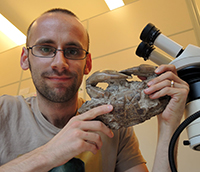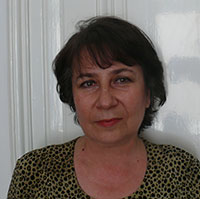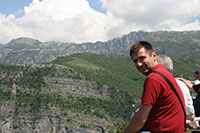 Rok Gašparič. Oertijdmuseum Boxtel, Bosscheweg 80, 5293 WB Boxtel, the Netherlands. rok.gasparic@gmail.com
Rok Gašparič. Oertijdmuseum Boxtel, Bosscheweg 80, 5293 WB Boxtel, the Netherlands. rok.gasparic@gmail.com
Rok Gašparič studied geology at the University of Ljubljana and has been working on fossil decapods for the past 25 years. Currently, he is an associated researcher at Oertijdmuseum De GroenePoort, and a PhD candidate at University of Ljubljana, working on his doctoral thesis which focuses on taxonomy, palaeoecology, and palaeobiogeography of fossil decapod crustaceans from Slovenia and neighbouring countries. His current taxonomic work includes a variety of fossil material from Triassic anoxic lagoons of the Alpine Tethys to the Miocene sandy shores of the Paratethys. Rok is also interested in improvements in imaging and visualization techniques in palaeontology,enabling better insight intofossil decapod morphology and improving the presentation of palaeotological work to the interested public.

 Matúš Hyžný. Department of Geology and Palaeontology, Faculty of Natural Sciences, Comenius University, Mlynská dolina G1, Ilkovičova 6, Bratislava 842 15, Slovakia; Geological-Paleontological Department, Natural History Museum Vienna, Burgring 7. A-1010 Vienna, Austria. hyzny.matus@gmail.com
Matúš Hyžný. Department of Geology and Palaeontology, Faculty of Natural Sciences, Comenius University, Mlynská dolina G1, Ilkovičova 6, Bratislava 842 15, Slovakia; Geological-Paleontological Department, Natural History Museum Vienna, Burgring 7. A-1010 Vienna, Austria. hyzny.matus@gmail.com
Matúš Hyžný received his Ph.D. from Comenius University in Bratislava (Slovakia) in 2012; his doctoral thesis was titled "Malacostracan associations of the Central Paratethys – systematics, taphonomy, palaeoecology and palaeobiogeography". In 2013–2015 he was a research associate at the Natural History Museum in Vienna (Austria) where he studied the Cenozoic biogeography of Western Tethys decapod crustaceans. His interests cover the systematics, fossil record and biogeography of decapods with a special reference to axiidean ghost shrimps. However, he feels at home with any group of malacostracan crustaceans including mantis shrimps and isopods.

 Gordana Jovanović. Natural History Museum Belgrade, Njegoševa 51, 11000 Belgrade, Serbia. gordana.j@nhmbeo.rs
Gordana Jovanović. Natural History Museum Belgrade, Njegoševa 51, 11000 Belgrade, Serbia. gordana.j@nhmbeo.rs
Gordana Jovanović works as a curator (Cenozoic invertebrates). In addition, she organised exhibitions around the Serbia and was often responsible for writing catalogs and other content supporting exhibitions. She has studied collections of the Museum, and has collected fossils from Serbia and Bosnia and Hercegovina. Her interests cover the systematics, biostratigraphy and paleoecology of Miocene molluscs with a special reference to bivalves. Her doctoral thesis was titled “Badenian bivalves of the southeastern fringe of Panonian Basin (Central Paratethys)”.

 Stjepan Ćorić. Geologische Bundesanstalt, Neulinggasse 38, 1030 Wien, Austria. stjepan.coric@geologie.ac.at
Stjepan Ćorić. Geologische Bundesanstalt, Neulinggasse 38, 1030 Wien, Austria. stjepan.coric@geologie.ac.at
Stjepan Ćorić received his PhD at Vienna University (Austria) at the Department of Palaeontology in 2003. In his doctoral thesis, he investigated the lower and Middle Miocene calcareous nannofossils from Austrian, Slovenian and Bosnian part of the Central Paratethys. At the Geological Survey of Austria he maps Flysch and Molasse sediments in Austria and does biostratigraphy based on calcareous nannofossils. In recent years, he is additionally interested in biostratigraphy of Paleogene sediments in Dinarides.

 Sejfudin Vrabac. Faculty of Mining, Geology and Civil Engineering Tuzla, Univerzitetska 2, 75000 Tuzla, Bosnia and Herzegovina. sejfudin.vrabac@untz.ba
Sejfudin Vrabac. Faculty of Mining, Geology and Civil Engineering Tuzla, Univerzitetska 2, 75000 Tuzla, Bosnia and Herzegovina. sejfudin.vrabac@untz.ba
Vrabac Sejfudin was born in Tuzla (Bosnia and Herzegovina) in 1955. PhD thesis: „Paleogeography southern margin of the Pannonian Basin in the Badenian and Sarmatian“, defended in 1990. at the University of Tuzla. Today he is a full professor of Geological Department at the University of Tuzla. His published scientific papers (72) mainly related to paleontological (foraminifera and molluscs), biostratigraphical, and paleogeographical characteristics the Badenian and Sarmatian of the Central Paratethys.

